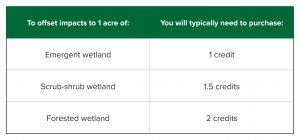You Can Bank on WSSI’s Success
Along with creating Virginia’s first wetland mitigation bank we also developed the mitigation bank that was the first to sell stream credits and the first mitigation bank dedicated solely for that purpose in Virginia. More recently, WSSI has developed mitigation banks that provide nutrient credits (through land conversion and/or stream restoration) to aid localities in meeting their nutrient reduction targets related to compliance with TMDLs or MS4 requirements. In addition, WSSI’s mitigation banks provide economical mitigation solutions through expedited permitting and assumption of monitoring and performance standards.
Purchasing Credits
Using bank credits saves time and money; it expedites the permitting process and avoids the burden of monitoring and maintaining a project-specific compensation site. WSSI currently has wetland and stream credits available in the Middle Potomac watersheds; click here to see a map. If your project appears to be located in or just outside a service area, please contact us; our GIS department can overlay your project’s location onto the service area map to precisely determine coverage. If you want to retain credits, please submit a Mitigation Purchase Request Form.

Wetland compensation ratio guidelines have been established by the U.S. Army Corps of Engineers (COE); the amount of bank credit required is based on the type of wetland impact. (The compensation ratio for impacts to surface waters is determined per project.)
For streams in Virginia, the compensation requirement is determined using the Unified Stream Methodology (USM), which was also developed by Virginia Department of Environmental Quality (DEQ), in conjunction with COE. The USM uses a Stream Assessment Form to evaluate the quality of each stream impact on the project site (which is summarized by a Reach Condition Index value) and determine the Compensation Requirement (CR), or stream credits, required to offset that particular impact. Projects with multiple stream impacts simply add all the individual reach CR values to summarize the project’s total stream mitigation requirement. The USM manual and all its associated forms can be found on DEQ’s Mitigation webpage.
Because one of our banks, the Northern Virginia Stream Restoration Bank (NVSRB), pre-dates the USM, we have stream credits available in a second currency – Stream Condition Units (SCUs). In some cases, the cost of mitigation requirement is less when using SCUs from the NVSRB, particularly for low quality streams with small drainage areas. To calculate the number of SCUs a project requires, simply enter the Reach Condition Index values obtained from the USM into our NVSRB Credit Estimation Form (click link to download form), along with the drainage area size of each stream impact.
Questions?
If you have questions regarding these methodologies, how to request wetland or stream credits, our wetland mitigation banking services, or project-specific concerns, please contact us.

